Ice Storms 1998 and 2013: Compare and Contrast
My Christmas holiday is my favorite of the year. I take a week and a half off from work and make as few plans as possible. Knitting, spinning, reading, cooking and eating good food, spending time with family and friends, and general indolence are my priorities.
This year our holiday plans were rearranged by an ice storm that brought back memories of Ice Storm ’98, the only natural disaster I’ve directly experienced. We were lucky - the storm fell short of the ’98 standard in the end. Still, it was a major weather event that will affect the rest of the winter and that will require hours and hours of clean-up work come spring.
I wrote a 100 page journal in 1998, so I have a historical record to refer to as I compare and contrast my memories of the two weather events. It surprises me to find myself emotionally moved by the tale of those days, when we had a 9 year old daughter and 84 year old stepparent in our home. She’s all grown up and he is dead, but my words bring back memories of them, and of a younger me.
Onset: Advantage 2013
The most eerie similarity was in the onset of the two storms. In both cases, the icy rain fell for days and built up gradually. My journal says that the icing began on Monday January 5 and concluded with a heavy rainstorm during the night of January 7. The December 2013 storm began on Friday December 20 and ended on Sunday, with ice building up gradually.
A key difference between the storms: on Sunday night, the temperature rose above freezing and stayed there all night. When we woke up the next morning, much of the built-up ice had fallen from the trees, and the world looked much less dangerous. I don’t record in my journal when “ice off” occurred in 1998, but it seems to have been days later.
Length of Power Outage: Advantage 2013
In 1998, we lost power early in the morning on January 8, and had power restored on January 26 - that’s 19 straight days of power loss. We bought a generator from out of area, and hooked it up for the first time on January 15. I’m still grateful to my stepmom for researching an appropriate machine and finding a supplier. That generator now lives in a cute A-frame shed next to our power entrance, and kept us comfortable nearly 16 years later.
Compared to 1998, this outage was a piece of cake. We lost power on December 21 and had it restored on December 23.
Damage to Infrastructure: Advantage 2013
Our basic support systems took heavy damage in 1998. On the fourth day of the disaster, a friend came over with a log skidder to open up our very long driveway, which was covered with downed trees. The skidder pushed the trees aside like matchsticks, but on its way out, a downed power line caught on the skidder’s axle, and the machine pulled down the entire line along our driveway, snapping the pole with our main entrance in half.
We also lost our running water, which was a crappy system anyway. We brought water up to our house from a well that had been drilled in the wrong place, above ground across ledge rock, over a brook, and underground up a hill. We had to run a trickle all winter to keep the system from freezing up, and it froze solid early on with no pump to keep that trickle going.
When I remember what our homeowner’s insurance did for us, replacing our main electrical entrance and paying for a new drilled well right by the house, I pay my premiums without complaint.
In 2013, we had one broken window, from a branch falling from a tree.
Damage to Trees: Advantage 2013
Here’s a quote from my 1998 journal: “Almost every tree south of the house is broken - tops broken off. Only the evergreens are intact. Of the three maples next to the house one is probably gone and one is not in very good shape. The poplars in front of the house look like ship’s masts.”
One thing we learned in the aftermath of 1998 is that trees have amazing recuperative powers. We gave many maple and black cherry trees around our home a chance, and they grew new branches and regained health and beauty.
Those darn poplars were goners, though. Good riddance.
We have plenty of fallen limbs on the ground from the 2013 storm, but damage is significantly lighter than 16 years ago. We heard a lot less crack - whoosh - tinkle, which was the constant sound for a couple of days in 1998. That said, some of the trees near our house that were spared in 1998 may not be so lucky this time. One maple tree that is dangling a broken branch above our solarium windows will surely go. Robert and I are both wondering if our choice to have a lot of trees growing close to our home is a wise one, and we aren’t going to keep any tree with a significant flaw.
Household logistics: Advantage 2013
Simply put: fewer people with fewer needs. In 1998 we had a 9 year old child and a partially disabled 84 year old man living with us. This time it was just the two of us.
Connectivity and Technology: Advantage 2013
Re-reading my journal, I am struck with how isolated we felt in the early days of the 1998 storm. We lost phone service, and that loss was wide spread throughout our region. Because Robert was Town Supervisor at the time, the phone company ran a line on top of the snowbanks to hook us up again; if he had not been a “very important man”, who knows how long we would have had to wait. My journal records our searches for functioning radio stations for news, and our happiness when the local public radio station went back on air. (Fortunately we had a radio with batteries.)
Now there is a cell phone tower a mile from us that was up and running throughout the power outage. Not only did we never lose phone service on our cells, we never lost access to the Internet. Woah. Just like remote areas in less developed parts of the world, where cell phones connect people to the world. I’ve read the thoughts of people who think that phones are more powerful devices than computers, and I feel like I experienced that first hand.
One weakness we have addressed: we were using phones on our landline that required electricity to function. They are gone, replaced by a Cortelco phone that gives us all the goodies we love, like a digital screen showing caller ID of incoming calls, but needs only to be hooked to the phone line. No more power adapter on our phone!
Emergency Preparedness: Advantage 2013
Our utility companies and local governments were poorly prepared for a major ice storm in 1998. Right-of-ways were clogged with underbrush grown too big, communication systems were poorly developed, and preparedness was on a back burner. Cue Frank Zappa: “It Can’t Happen Here.”
There’s been a greater emphasis on emergency preparedness everywhere you look since then, and there’s a formal structure designed to get up and running quickly to address needs. On the county level, we were fortunate that one of the County’s most effective department heads was serving as interim head of emergency services. On the local level, our highway and fire departments were on the job from the first indications that we had another major storm on the way. The clean-up from 1998 removed a lot of trees from the right-of-ways, and our town and utilities are more aggressive than they used to be at keeping growth cut back, so there were a lot fewer down lines.
Personal preparedness was better, too, mainly due to that generator. We have areas of needed improvement, though. Our oil lamps need new wicks, and we couldn’t find a reserve of lamp oil. We also need to make sure we have an adequate stock of batteries of different sizes on hand at the beginning of winter.
Physical Strength and Stamina: Advantage 1998
Another place where the facts are simply put: Robert and I are 16 years older. Also, Robert was struck with a vicious viral infection as the ice started to fall, and was sick and exhausted for the entire storm.
Some photos of the 2013 storm:
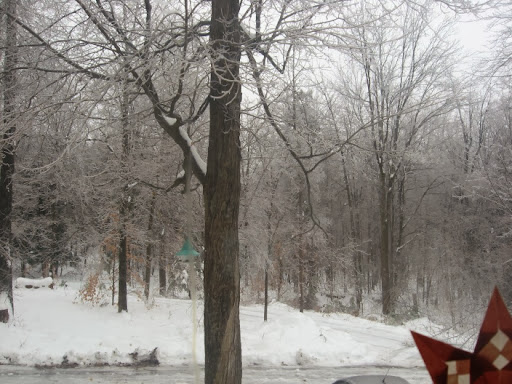
The view from the kitchen window on Saturday 12/21.
The rest of the pictures were taken on Sunday 12/22.
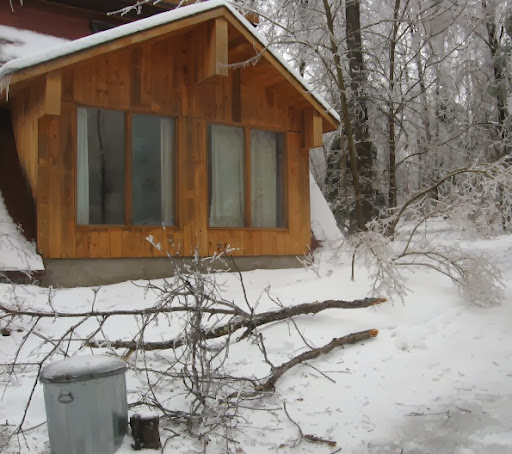
Fallen black cherry limbs.
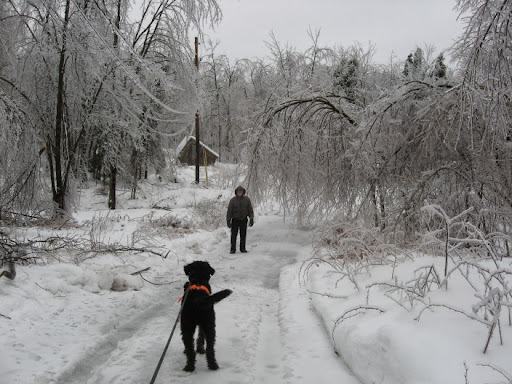
We go for a walk. Robert and Samwise provide scale as we head away from the house towards an outbuilding.
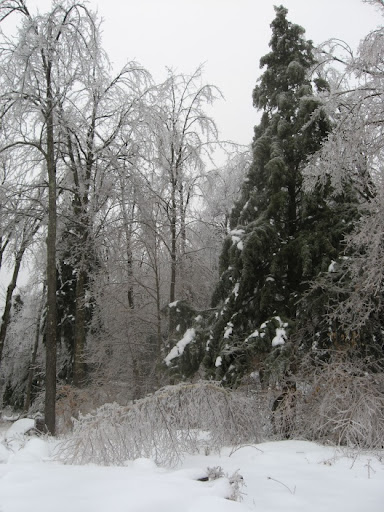
Horizontal birch and constricted evergreens.
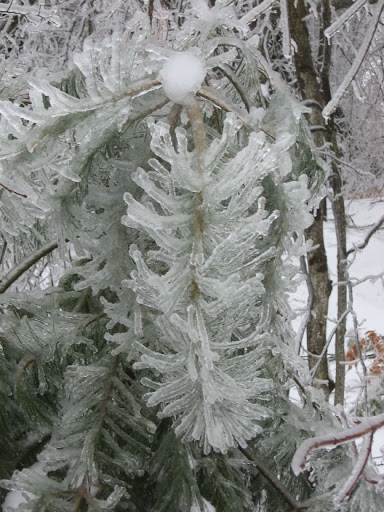
The top of a young white pine. The top eventually snapped off of this tree. Its lifespan is doomed to be short in any event, as it is growing in the right-of-way under the power lines.
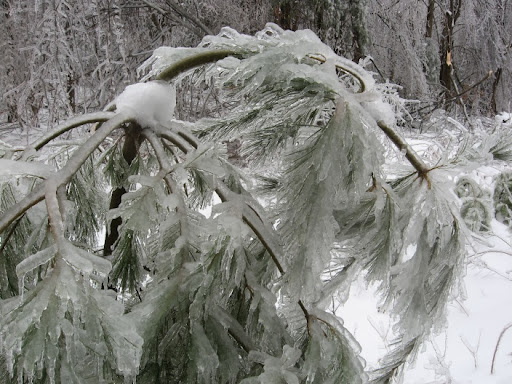
Another doomed young white pine.

The only place along our power line where an overhanging tree would short out the line.
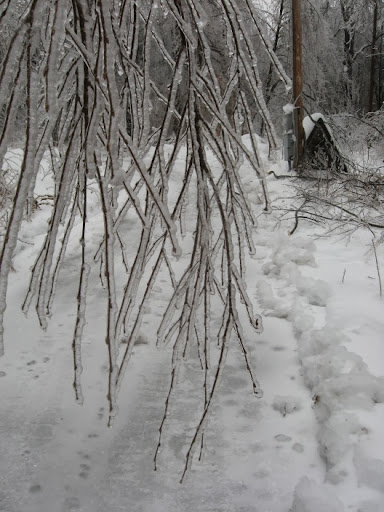
An icy lattice wall, and the shed that houses our trusty generator. That’s another tree that is already history, pushed down by the heavy equipment that finished clearing our driveway.

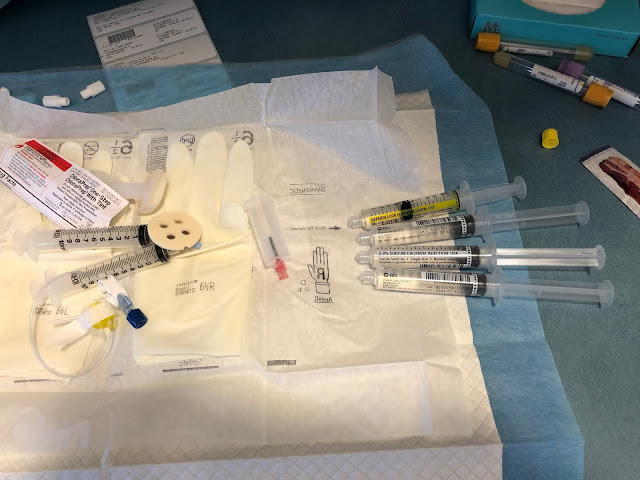
Comments
Post a Comment